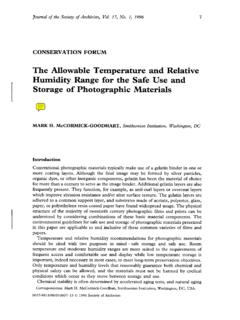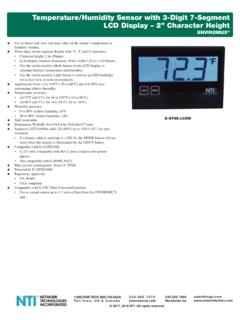Transcription of 2553856 A Humidification Load Calculation Manual
1 Humidification load Calculation Manual Engineering Manual Includes What is humidity , Affects of relative humidity , Calculating relative humidity , Requirements to Calculate Humidifier load , and load Calculations 2553856 -A | 08 SEP 2010 When You Need humidity ! Thank you for choosing Nortec. Proprietary Notice This document and the information disclosed herein are proprietary data of WALTER MEIER LTD. Neither this document nor the information contained herein shall be reproduced used, or disclosed to others without the written authorization of WALTER MEIER LTD., except to the extent required for installation or maintenance of recipient s equipment. All references to the Nortec name should be taken as referring to WALTER MEIER LTD. Liability Notice Nortec does not accept any liability for installations of humidity equipment installed by unqualified personnel or the use of parts/components/equipment that are not authorized or approved by Nortec.
2 Copyright Notice Copyright 2009, WALTER MEIER LTD. All rights reserved. Contents 5 What is humidity 6 Effects of relative humidity 6 Static Electricity 7 Moisture Stability 8 Health and Comfort 10 Calculating relative humidity 12 Requirements to Calculate Humidification load 12 Design Conditions Selecting an RH Setpoint 16 Outdoor Air Conditions 22 load Calculations 22 Natural Ventilation 23 Mixed Air System 23 Makeup or Exhaust Air System 5 | Humidification load Calculation What is humidity If a closed container is partially filled with water, then some of the water molecules in the liquid will leave the surface of the water and become vapor. Once some water molecules are present as vapor they will also re-enter the liquid. After some time at constant temperature equilibrium will be reached where the same number of molecules are leaving and entering the liquid.
3 At this equilibrium point the relative humidity of the water vapor is 100%. Figure 1: Water Vapour Equilibrium The equilibrium point is temperature dependent. At higher temperatures the equilibrium occurs with more water vapor. If the container above was heated to 86 F (30 C) the water and water vapor would no longer be in equilibrium. The relative humidity of the vapor right after increasing the temperature would be 57%. This means that immediately after heating there are 57% as many water vapor molecules as would be present in the equilibrium state. Figure 2: relative humidity after Heating It is the above process that causes dry air in buildings. As cold incoming air is heated, its relative humidity value drops. Therefore moisture must be added to attain an acceptable level of humidity within the building. load Calculations - on page 22 outlines how to calculate the amount of moisture that must be added to maintain a constant relative humidity .
4 relative humidity (RH) is the percentage of water vapour present in the air relative to the amount that would be present in the equilibrium state. Equilibrium68 F (100% RHWater vapor ( )20 C)WaterWater Va p o r=Equilibrium68 F (RH = 100% ( )20 C)WaterWaterVa p o r=WaterWaterVa p o r>Heat to 86 F(30 C )Not in Equilibrium86 F (RH = 57% ( )30 C)Equilibrium86 F (RH=100% ( )30 C)Given timeand sufficient waterWaterWaterVa p o r= Humidification load Calculation | 6 Effects of relative humidity The reasons for humidifying dry air vary from one building to another and from one geographic area to another, however there are three fundamental reasons. These are: Static Electricity Poor Moisture Stability Health and Comfort Static Electricity Static electricity is a condition caused by stationary charges of electricity and is a major problem in most unhumidified areas. Since static electricity is caused by friction, particularly when the elements in friction are dry, the problem increases proportionately with the speed of production machinery.
5 Without sufficient Humidification , high-speed machinery might well defeat its own purpose. Reduced efficiency is frequently the result of static electricity. In the printing industry presses must self-feed paper evenly, one sheet at a time at very high speeds. When the static electricity causes sheets of paper to stick together, the paper bunches, the feeding becomes uneven, and eventually the paper jams the presses. In the textile industry static electricity causes the yarns to adhere to each other, the shuttles miss threads and improper weaving patterns result. In offices, static electricity can disrupt operations and increase operating costs. In many photocopiers, sheets of paper stick together and jam the machine, wasting time and paper. Severely jammed equipment may even require service calls. In computer rooms and data processing areas, the lack of humidity results in static electricity that causes problems such as circuit board failure, dust buildup on heads, and storage tape breakage.
6 Static electricity can also be dangerous. Sparks caused by static are extremely hazardous in locations such as hospital operating rooms where flammable gases are present. Many flash fires even explosions - are caused by static electricity. Controling Static Electricty One of the easiest and most common methods of minimizing static electricity is to increase the relative humidity level. Electrostatic charges do not dissipate through moist air, but through a moisture film that is absorbed on the charged surfaces. This moisture film decreases the surface resistance and causes static charges to be drained. This effect is most pronounced at RH above 30-35% and it also corresponds with a decrease in ozone production (a by-product of electrostatic discharge). Static electricity is a problem that should be of primary concern to any manufacturing plant interested in running efficiently and accurately. Controlling Static Electricity - Maintaining relative humidity above 35% is one important measure that can be taken to reduce static electricity.
7 7 | Humidification load Calculation Moisture Stability When air is heated the relative humidity will decrease. When this occurs the rate at which water molecules leave objects containing water or the rate at which water evaporates is increased. All hygroscopic or fibrous materials either lose of gain moisture in direct relation to the relative humidity of the surrounding air Moisture stability is the ability of a material to maintain a level of moisture content despite fluctuations in the humidity of the environment. Many materials give off, or take on moisture rapidly which can result in serious damage to the material or the process in which it may be involved. The drying out of a material can result in product deterioration, while conversely, a dry material can also suffer damaging side effects of moisture regain. In many cases, product deterioration is directly related to the lack of moisture stability Table 1 gives the hygroscopic regain of some common hygroscopic materials.
8 Hygroscopic regain is defined as the amount of water a completely dry material will absorb from the air. It is expressed as a percent of the dry weight. (For example the weight of completely dry timber will increase by if it is stored at an RH of 50%) Table 1: Hygroscopic Regain of Some Common Materials relative humidity - % Industry and/or Material 10 20 30 40 50 60 70 80 90 Baking Crackers 5 Flour 8 White Bread 19 Leather - Sole Oak, Tanned 5 16 24 Printing Paper Comm. Ledger 75% Rag1% Ash 5 Paper Newsprint 24% Ash 4 Paper White Bond Rag 1% Ash Paper Writing 3% Ash 3 Textile Cotton Absorbent 9 Cotton American-cloth 10 Cotton Sea Isle-roving Hemp Manila and Sisal 6 Jute Average Grade Linen Dried Spun Yarn Rayon Celulose Acetate Fibre 3 Rayon Cupramonium Average Skein 4 10 Rayon Viscose Nitrocel 4 16 Silk Raw Chevennes-Skein 8 Wool Australian-Marino-Skein 7 Tobacco - Cigarette 11 16 25 50 Wood Timber Average 3 14 22 Glue Hide 9
9 Miscellaneous Charcoal-Steam Activated 30 Gelatin Silica Gel Soap 10 Starch NOTE: Moisture content expressed in per cent of dry weight of the substance at various relative humidities Temperature 75 F (22 C) Humidification load Calculation | 8 Products such as vegetable, cut flowers, fruit and many grocery items cannot be brought back to original quality once they have lost their moisture. By installing an efficient Humidification system this costly loss of products can be avoided. Many food processors humidify their plant and storage areas and are able to store fruits and vegetables for months without any loss of product quality or weigh. For any product that requires a certain percentage of moisture to maintain its quality, loss of that moisture reduces its valve. Some products can be brought back to their original condition by returning the moisture to them.
10 However, among those that cannot reabsorb moisture to regain their lost quality are fruit and vegetable products, paintings and art objects. Deterioration caused by loss of moisture is also a problem for treasures such as antiques, rare books, and works of art, all of which are susceptible to damage caused by moisture loss. It causes antiques, paintings, paper and book bindings to crack, warp and deteriorate. Fortunately, most libraries and museums are well aware of the need for controlled humidity to protect their collections. They know that proper humidity control is a very inexpensive preventive measure that will avoid costly and often impossible restorations. A specific moisture content in materials is essential to the quality of products produced by a wide range of manufacturers of hygroscopic or fibrous materials. Wood, paper and textiles are examples of materials particularly affected by changes in content. If these materials have a correct moisture content when they arrive at a plant, and if they are used immediately, they will respond properly to the manufacturing process.







